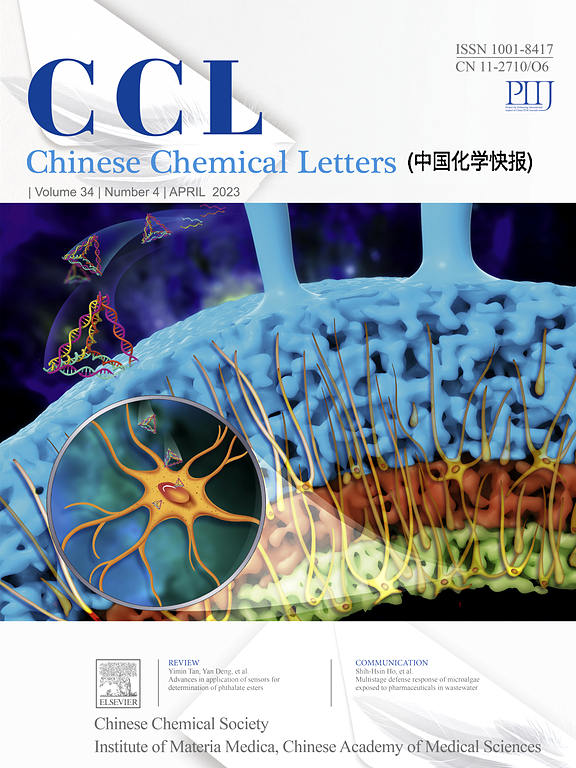利用瓜bbbbil和经典聚集猝灭化合物通过多种非共价相互作用制备可调色长余辉防伪材料
IF 9.4
1区 化学
Q1 CHEMISTRY, MULTIDISCIPLINARY
引用次数: 0
摘要
本文主要研究了利用葫芦b[6]作为主体化合物开发长效余辉材料。通过有策略地控制Q[6]的外表面相互作用,荧光素钠(FluNa)和钙黄素钠(CalNa)等经典的聚集引起猝灭(ACQ)化合物在紫外线照射下转化为具有不同颜色和持续时间的余辉材料。这种转变是通过主客体掺杂方法与金属离子配合实现的。即使在5 × 10-5 wt%的掺杂浓度下,材料也表现出显著的余辉特性,持续时间长达2s,磷光寿命长达150 ms。此外,通过调节客体化合物的浓度,材料的持续发光颜色可以很容易地从橙色过渡到黄色,然后再过渡到绿色。这些发现表明,所开发的余辉材料在紫外线照射下具有多层次防伪和信息加密应用的巨大潜力。超分子组装策略依赖于葫芦[n] il的外表面相互作用,为制作多色发光材料提供了一种更简单、更有效的方法。此外,该方法为提高聚合猝灭(ACQ)化合物在各个技术领域的应用潜力开辟了道路。本文章由计算机程序翻译,如有差异,请以英文原文为准。
![Developing color-tunable long afterglow anti-counterfeiting materials using cucurbit[6]uril and classical aggregation-caused quenching compounds through multiple non-covalent interactions](https://img.booksci.cn/booksciimg/2025-1/102304881311782022460.jpg)
Developing color-tunable long afterglow anti-counterfeiting materials using cucurbit[6]uril and classical aggregation-caused quenching compounds through multiple non-covalent interactions
This investigation focuses on the utilization of cucurbit[6]uril (Q[6]) as the host compound for the development of long-lasting afterglow materials. By strategically manipulating the outer surface interactions of Q[6], classical aggregation-caused quenching (ACQ) compounds such as fluorescein sodium (FluNa) and calcein sodium (CalNa) were transformed into afterglow materials with varying colors and durations upon exposure to ultraviolet light. This transformation was facilitated through a host-guest doping method combined with coordination with metal ions. Even at a reduced doping concentration of 5 × 10–5 wt%, the materials exhibit remarkable afterglow properties, lasting up to 2s, with a phosphorescence lifetime of up to 150 ms. Moreover, by adjusting the concentration of the guest compound, the persistent luminescence color of the materials could be easily transitioned from orange to yellow and subsequently to green. These findings suggest that the developed afterglow materials hold significant potential for multi-level anti-counterfeiting and information encryption applications when exposed to ultraviolet light. The supramolecular assembly strategy, which relies on the outer surface interactions of cucurbit[n]uril, offers a simpler and more efficient approach to crafting multi-color luminescent materials. Additionally, this method opens avenues for enhancing the application potential of aggregation-caused quenching (ACQ) compounds in various technological domains.
求助全文
通过发布文献求助,成功后即可免费获取论文全文。
去求助
来源期刊

Chinese Chemical Letters
化学-化学综合
CiteScore
14.10
自引率
15.40%
发文量
8969
审稿时长
1.6 months
期刊介绍:
Chinese Chemical Letters (CCL) (ISSN 1001-8417) was founded in July 1990. The journal publishes preliminary accounts in the whole field of chemistry, including inorganic chemistry, organic chemistry, analytical chemistry, physical chemistry, polymer chemistry, applied chemistry, etc.Chinese Chemical Letters does not accept articles previously published or scheduled to be published. To verify originality, your article may be checked by the originality detection service CrossCheck.
 求助内容:
求助内容: 应助结果提醒方式:
应助结果提醒方式:


